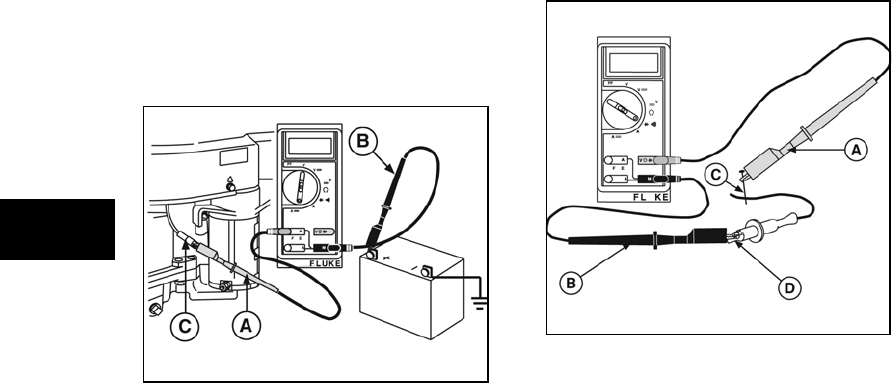
34
2
2
5. Attach BLACK test lead clip to positive (+)
battery terminal.
NOTE: Negative (-) battery terminal must be
grounded.
Figure 17
6. With engine running at 3600 RPM, output
should be between 2 to 4 Amps DC.
• Output will vary with battery voltage. If
battery voltage is at its maximum, output
will be approximately 2 Amps.
7. If no or low output is found, test diode.
Test Diode
In the Diode Test position, the meter will display
forward voltage drop across the diode(s). If
voltage drop is less than 0.7 volts, meter will
“Beep” once as well as display voltage drop. A
continuous tone indicates continuity (shorted
diode). An incomplete circuit (open diode) will be
displayed as “OL.”
1. Insert RED test lead (A, Figure 18) into
the V Ω receptacle and set the rotary
switch to Diode position.
2. Insert BLACK test lead (B) into the COM
receptacle in the meter.
3. Attach RED test lead clip to (C) and Black
test lead clip to point (D). (It may be
necessary to pierce wire with a pin as
shown.)
Figure 18
• If meter “Beeps” once, diode is OK.
• If meter makes a continuous tone, diode
is defective (shorted).
• If meter displays “OL,” proceed to Step 4.
4. Reverse test leads.
• If meter “Beeps” once, diode is installed
backwards.
• If meter still displays “OL,” diode is
defective (open).
5. If diode tests OK, replace stator.
NOTE: Service replacement diode harnesses
are available. Use Rosin Core solder when
installing new harness. Use shrink tubing or tape
for all connections. Do not use crimp connectors.
14-Volt AC Alternator
The AC alternator provides current for headlights
only. Current for the lights is available when the
engine is running. To check, use 12 Volt lights
with a total rating of 60-100 watts. Alternator
output varies with engine speed. With lights rated
at 70 watts, the voltage rises from 8 Volts @
2400 RPM to 12 Volts @ 3600 RPM. The lights
should become brighter as the engine speed
increases.
